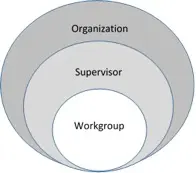The importance of a supportive climate for health in organizations
November 2016
Contributed by Zandra Zweber, Ph.D. is an industrial and organizational psychologist who is an Alumni Research Affiliate of CPH-NEW.
Download the PDF.
Employee health and wellness programs have become commonplace for most organizations, but does having these programs necessarily result in better health? Health promotion theory tells us that the social climate can predict health related decisions that individuals make.1 The Multifaceted Organizational Health Climate Assessment (MOHCA) scale was developed specifically for the purpose of assessing social climate for health in an organization, from the employee perspective.2 The full scale is provided on page 2 of this issue.
The MOHCA scale was developed with the theory in mind that there are multiple levels of influence within a workplace social system, including coworkers, supervisors, and the organization itself (Figure 1). To maximize the impact of workplace health and wellness programs, support for healthy behaviors needs to exist at each of these three levels or facets. The MOHCA considers how health is treated within workgroups, how supervisors support employee health and what the organization does to support employee health.
Measuring health climate may be useful for explaining the contextual aspects of the organization that can impact program implementation and impact. For example, when lunch time educational programs are not well attended, an organization may erroneously conclude that there was something about the program itself (e.g. topic unpopular, poor timing) that caused it to fail instead of considering the social climate. However, there could be a lack of support at the workgroup level and employees might feel judged by their peers for taking time out of their work day to attend health-related activities. In this scenario, the organization would not benefit from simply changing the topics of the lunch and learn activities; they would also need to focus on improving the social support for health.
Does an organization need to be strong at each of these three levels? A study using survey data from the Center for the Promotion of Health in the New England Workplace (CPH-NEW) explored whether all three of these facets (coworkers, supervisors, and the organization) are necessary in combination to experience the benefits of a healthy organization, or if strength in one facet can compensate for a lack of strength in another facet.3 Researchers found that employees who reported highly positive scores on all of the three facets fared better than employees scoring low on all three facets, or who were lacking in at least one facet on these health and well-being outcomes: such as civility norms, work ability, general mental health, stress, burnout and depression. 
Figure 1: Multifaceted Organizational Health Climate Assessment (MOHCA)
These findings suggest that organizations can benefit from evaluating all three facets of health climate separately and then using this evaluation to better support workplace health and wellness interventions. Organizations that recognize the importance of a positive health climate and measure it to see how it changes over time may be more successful at moving the needle on employee health outcomes.
Multifaceted Organizational Heath Climate (MOHCA) Assessment Questions
Organization-level questions
- My organization is committed to worker health and well-being.
- My organization provides me with opportunities and resources to be healthy.
- My organization encourages me to speak up about issues and priorities regarding employee health and well-being.
- When management learns that something about our work or the workplace is having a bad effect on worker health or well-being, then something is done about it.
Supervisor-level questions
- My supervisor sets performance norms that are in conflict with healthy behaviors.
- My supervisor encourages participation in organizational programs that promote worker health and well-being.
- My supervisor encourages health behaviors in my workgroup.
Coworker-level questions
- In general, workers frequently engage in unhealthy behaviors in my workgroup.
- If my health were to decline, my co-workers would take steps to support my
- In my workgroup, use of sick days for illness or mental health issues is supported and encouraged.
References
Stokols D1, Grzywacz JG, McMahan S, Phillips K. (2003) Increasing the health promotive capacity of human environments. Am J Health Promotion Sep-Oct;18(1):4-13. doi: 10.4278/0890-1171-18.1.4
Zweber ZM, Henning RA, Magley VJ [2015, November 16]. A practical scale for multi-faceted organizational health climate assessment. Journal of Occupational Health Psychology. Advance online publication, http://dx.doi.org/10.1037/a0039895.
Zweber ZM, Henning RA, Magley VJ, Faghri P. (2015). Considering the differential impact of three facets of organizational health climate on employees’ well-being. The Scientific World Journal, http://dx.doi.org/10.1155/2015/407232.
Zandra Zweber, Ph.D. is an industrial and organizational psychologist who is an Alumni Research Affiliate of CPH-NEW. Her research focuses on occupational health, workplace climate, and translating findings into actionable change in organizations.
CPH-NEW is a Center for Excellence to Promote a Healthier Workforce of the National Institute for Occupational Safety and Health. CPH-News & Views is a semi-monthly column written by Center researchers on emerging topics related to healthy workplaces. These comments reflect thoughts of the individual researchers and do not represent conclusive research summaries, nor do they necessarily reflect a consensus among all Center personnel.
We welcome your responses and discussion. Please send all questions and comments to CPHNEW@uml.edu
CPH News and Views Issue 49
